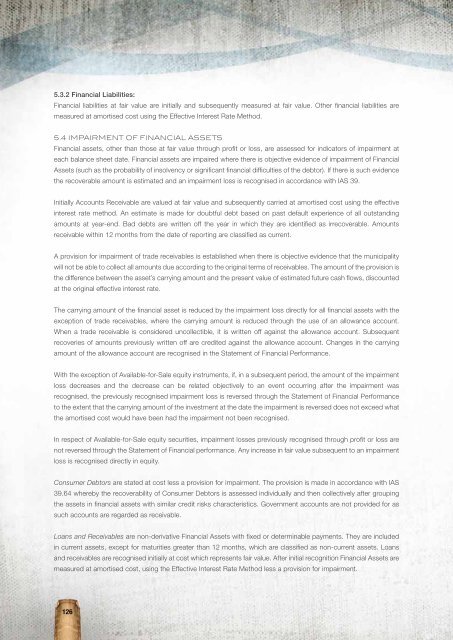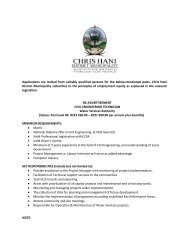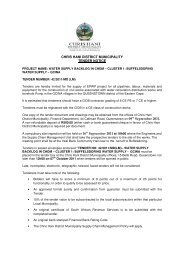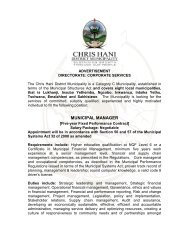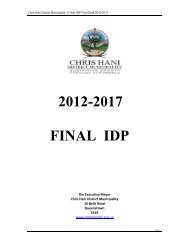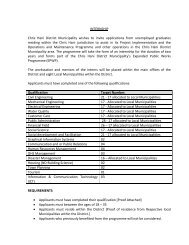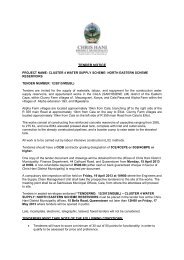Entire Document - Chris Hani District Municipality
Entire Document - Chris Hani District Municipality
Entire Document - Chris Hani District Municipality
Create successful ePaper yourself
Turn your PDF publications into a flip-book with our unique Google optimized e-Paper software.
5.3.2 Financial Liabilities:<br />
Financial liabilities at fair value are initially and subsequently measured at fair value. Other financial liabilities are<br />
measured at amortised cost using the Effective Interest Rate Method.<br />
5.4 Impairment of Financial Assets<br />
Financial assets, other than those at fair value through profit or loss, are assessed for indicators of impairment at<br />
each balance sheet date. Financial assets are impaired where there is objective evidence of impairment of Financial<br />
Assets (such as the probability of insolvency or significant financial difficulties of the debtor). If there is such evidence<br />
the recoverable amount is estimated and an impairment loss is recognised in accordance with IAS 39.<br />
Initially Accounts Receivable are valued at fair value and subsequently carried at amortised cost using the effective<br />
interest rate method. An estimate is made for doubtful debt based on past default experience of all outstanding<br />
amounts at year-end. Bad debts are written off the year in which they are identified as irrecoverable. Amounts<br />
receivable within 12 months from the date of reporting are classified as current.<br />
A provision for impairment of trade receivables is established when there is objective evidence that the municipality<br />
will not be able to collect all amounts due according to the original terms of receivables. The amount of the provision is<br />
the difference between the asset’s carrying amount and the present value of estimated future cash flows, discounted<br />
at the original effective interest rate.<br />
The carrying amount of the financial asset is reduced by the impairment loss directly for all financial assets with the<br />
exception of trade receivables, where the carrying amount is reduced through the use of an allowance account.<br />
When a trade receivable is considered uncollectible, it is written off against the allowance account. Subsequent<br />
recoveries of amounts previously written off are credited against the allowance account. Changes in the carrying<br />
amount of the allowance account are recognised in the Statement of Financial Performance.<br />
With the exception of Available-for-Sale equity instruments, if, in a subsequent period, the amount of the impairment<br />
loss decreases and the decrease can be related objectively to an event occurring after the impairment was<br />
recognised, the previously recognised impairment loss is reversed through the Statement of Financial Performance<br />
to the extent that the carrying amount of the investment at the date the impairment is reversed does not exceed what<br />
the amortised cost would have been had the impairment not been recognised.<br />
In respect of Available-for-Sale equity securities, impairment losses previously recognised through profit or loss are<br />
not reversed through the Statement of Financial performance. Any increase in fair value subsequent to an impairment<br />
loss is recognised directly in equity.<br />
Consumer Debtors are stated at cost less a provision for impairment. The provision is made in accordance with IAS<br />
39.64 whereby the recoverability of Consumer Debtors is assessed individually and then collectively after grouping<br />
the assets in financial assets with similar credit risks characteristics. Government accounts are not provided for as<br />
such accounts are regarded as receivable.<br />
Loans and Receivables are non-derivative Financial Assets with fixed or determinable payments. They are included<br />
in current assets, except for maturities greater than 12 months, which are classified as non-current assets. Loans<br />
and receivables are recognised initially at cost which represents fair value. After initial recognition Financial Assets are<br />
measured at amortised cost, using the Effective Interest Rate Method less a provision for impairment.<br />
126


